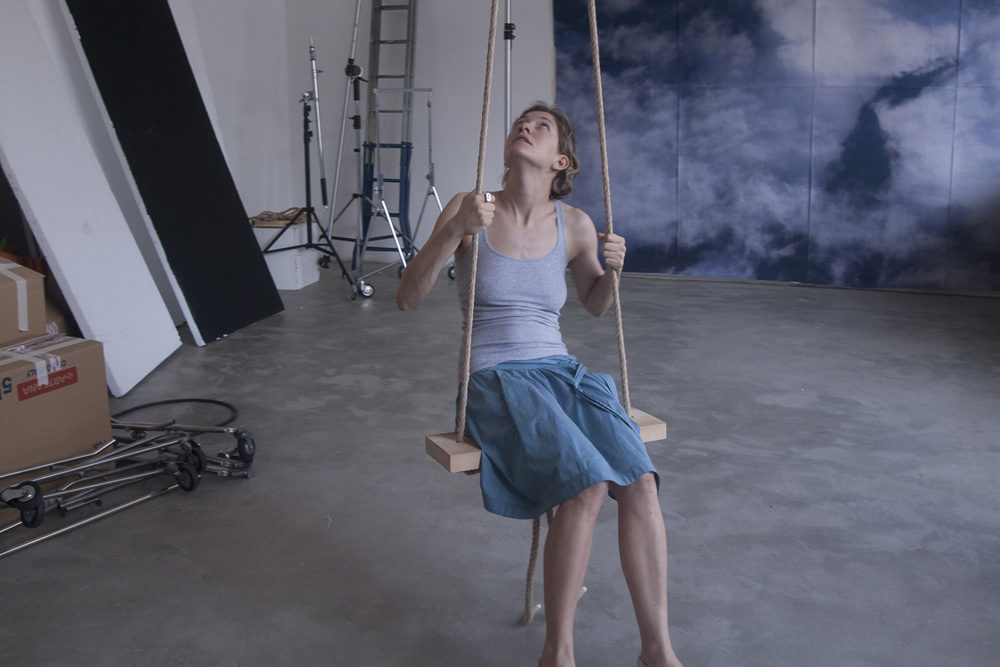Room 4
The work Mutter represents motherhood without a child and starts out as a tiny photo frame that develops into a 4 x 3 m billboard on the opposite side. In the veranda of Casa Testori, Mutter und Tochter is not so much a billboard as a wallpaper looking directly at us from the wall. The two images are hung in the veranda, which in its round, ambiguous architecture perfectly encapsulates the work in a cycle. One side leads to the area of everyday life; the other to the outside, to the garden. The two large photos are hung in the middle of the wall, facing each other. In the first, a girl is carrying her mother on her shoulder. The self-timer, still held in her hand, guides our gaze towards a photo on the ground depicting the newborn girl in her mother’s arms. In the second, the daughter turns around. The self-timer has been released from her hand and is under her foot in contact with the ground. Naked, the two figures look ahead, then into themselves. The two bodies merge into a collection of pieces of flesh. Their feet rest on the wooden floor of a real house, while the wallpaper induces a staging. And so the room repeats the installation itself, underlining the transition between past and present.
Julia Krahn
Since Julia Krahn’s work questions the permeability of the gaze between the identity of artist and spectator, it constantly deals with the question of memory. Everyday objects, symbols and traces of the past are thus redefined each time through the photographic image. But more than the narration of the passage of time or the construction of a story, Julia Krahn is interested in crystallising, transforming from a liquid to a solid state, the fragments of a private and secret reality. Julia’s works are characterised in this sense by an ambiguous fluidity: aesthetically attractive images, ultimately marked by an almost hermetic content […] Mutter is in fact a project in which the drama of the image is somehow intensified by the fear of forgetting and losing contact with the story chosen and constructed by the artist. The naked bodies, the embrace between mother and daughter, the reference to sacred symbolism manifest not only the attempt at survival, but also at re-signification, and therefore regeneration, that is entrusted to artistic practice.
Alessandro Castiglioni
Julia Krahn was born in Aachen, Germany in 1978 and moved to Milan in 2000, abandoning her medical studies to devote herself exclusively to photography. In 2001, she began working with Galleria Magrorocca in Milan and since then has exhibited in Italy and abroad, particularly in Spain, England and Germany. In 2001 she held her first solo exhibition entitled Intallation at the Schoking Space in Milan. In 2004 she participated in the project Whant you Yokeandzoom, London -Tokyo and held three solo shows in Milan, including eiapopaia_ninnananna at Galleria Openmind. In 2007 she held the exhibition The creation of Memory at Galleria Magrorocca and Denied Childhood at Museum Ludwigforum in Aachen. In 2008 she was runner-up at the Premio Arti Visive San Fedele in Milan and exhibited among the winners of the Premio de Fotografia de CCM, 5th in Barcelona. In the same year she was selected for the Tehran Biennial and was nominated as the best children’s photographer in Italy by Tau Visual. In 2009 she exhibited Engelstueck at Galleria Magrorocca in Milan, participated in MACO Mexico in Mexico City and PaxBank in Aachen. In 2010 she participated in Art Scope in Basel represented by Galleria Magrorocca and in 2012 she presented a solo exhibition at the Zircumflex studio in Berlin.






